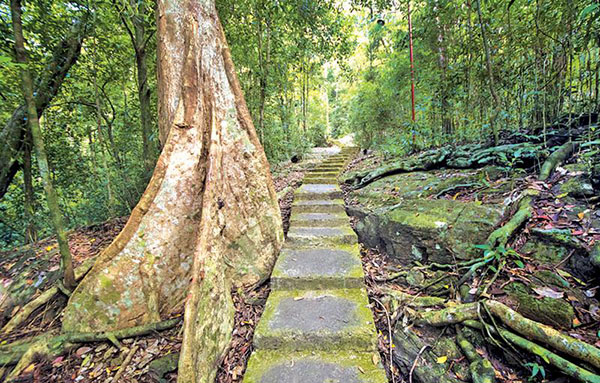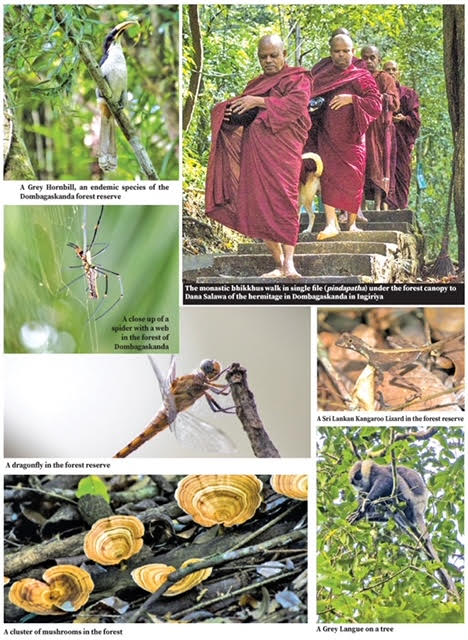A walk through the rainforest-by MAHIL WIJESINGHE

Source:Sundayobserver
The Dombagaskanda rainforest is a place of exceptional beauty, the Ceylon grey horn-bills nestling in the hole of a giant tree and little edible-nest swiftlets darting in and out of deep rock caves. From the east of Ingiriya to the extreme west of Horana on the bank of the Kalu Ganga is the Dombagaskanda hill, and exploring this remote forest reserve can be exhilarating as it is humbling.
I love nature because I grew up with the jungle hamlet of Botalegama close to Dombagaskanda. Dombagaskanda is not a strange place to me as I often visit the monastic bhikkhus of the forest hermitage and the pristine rainforest that they frequent. I carry my constant companion, the Nikon camera with me to capture the ever changing eco system of the forest whenever I visit.
Dombagaskanda has been a protected forest reserve since 1955 belonging to the Forest Department. The reserve consists of some 262 hectares of tropical rainforest in the forested-hill on the bank of the Kalu Ganga in the outskirts of Ingiriya in the Kalutara district.
To reach the Dombagaskanda forest, one has to travel on the Panadura-Ratnapura (A-8) highway, turn left at the Aduragala junction if you are travelling from Ingiriya and proceed a further two kilometres along the minor road, leading to the Kalu Ganga. Before reaching the river, the road branches off to the left. Continue for another 1.5 kilometres and arrive at the foot of Dombagaskanda. Although the road up to the hill is motorable, it is best to get off the vehicle and walk through the forest.
Forest hermitage
It also directs you to the Dombaskanda forest hermitage. The forest hermitage of Dombagaskanda was founded by Ven. Olaboduwe Sri Revatha Dammakirthi Thera in 1955. Today, the hermitage has several constructions including Kutis, meditative walkways and medical halls linked together and developed as a reputed forest hermitage in the country with 15 resident monastic bhikkhus. The bhikkhus at the hermitage do not like to be disturbed and eco-tourists should not continue beyond the flight of steps which lead to the kutis (abode) to the hermitage without prior permission.
As I began my walk on the gravel road, although it was a sunny day, I heard the sound of rain. Walking further up, I realised that it was not the sound of rain but the sound of a stream flowing down the mountain where endangered fish are spotted. In the distance I caught a glimpse of the brownish water of the Kalu Ganga which flows by the side of the Dombagaskanda hill.
Inhabited by over 100 species of birds, half of which are rare and endemic to Sri Lanka, Dombagaskanda has been making slow but big strides on the birding map of the country. The tropical low country rainforest attracts bird-watchers, scores of photographers and researchers. Disturbing the fauna and flora is prohibited in the forest reserve.
As I walked under the towering trees and the dimly lit foliage, I spotted a variety of birds and a large number of endemic Toque macaques and Purple faced Leafy monkeys prospecting for food and seemed to be increasingly confident in approaching people who usually give food at the hermitage. In my previous visits, I spotted several jungle fowls in the forest, but this time, I didn’t see any.
Silence of tranquil
I saw and heard the alarming sound of Giant Squirrels that gives out a boisterous noise breaking the silence of the tranquil forest. Small creatures are plenty in the forest. I spotted a few Kangaroo Lizards displaying dull colours. The forest is also home to rare butterflies and dragonflies.
It is imperative that the ecological balance of the forest reserve is maintained. Otherwise, scores of species native to Dombagaskanda will soon be endangered and be lost. It is perfectly protected because of the forest hermitage and the monastic bhikkhus’ aim is protect its fauna and flora while living in the forest as the Buddha had preached through his sermons. The images here are a small sampling of the richness of the pristine forest. However, the streams of the forest are believed to be polluted due to the throwing away of non-biodegradable polythene wrappers by visitors. I left the Dombagaskanda forest reserve with joy in my heart, having witnessed its serenity and tranquility. The happiness I enjoyed, a few minutes under the canopy of lush green, away from the sights and sounds of the outside world, was more than words can express.









No Comments